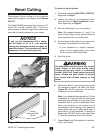
G0609 12" Parallelogram Jointer
-21-
Table Movement: To move the infeed table,
loosen the table lock (Figure 17), move the table
with the table handwheel in the preset range,
then tighten the table lock. The outfeed table is
preset with no range of movement allowed, so
if it gets accidentally unlocked it will not move.
To adjust the preset range of movement, refer to
SECTION 7: SERVICE,
Page 32 about setting
table heights.
Fence Movement: The fence has a lock handle
that keeps it in position (Figure 18). To move the
fence, loosen the lock handle and slide the fence
where needed.
Fence Tilting: The tilt lock (Figure 18) secures
the fence at any position in the available range.
The stop block sets the fence tilt to 90°. Positive
stops stop the fence at 45° inward and 45° out
-
ward, for common 45° bevel cuts. Even when the
fence is resting against the positive stops, the tilt
lock must be tightened before cutting.
Figure 17. Table control locations.
Figure 18. Fence lock, tilt lock and stop block
locations.
Infeed
Table Lock
Infeed Table
Handwheel
Stop Block
Fence
Tilt Lever
Fence Lock
Handle
Tilt Lock
Here are some rules to follow when choosing
and jointing stock
:
• DO NOT joint or surface plane stock that
contains knots. Injury to the operator or
damage to the workpiece can occur if the
knots become dislodged during the cutting
operation.
• DO NOT joint or surface plane against the
grain direction. Cutting against the grain
increases the likelihood of stock kickback, as
well as tear-out on the workpiece.
• Jointing and surface planing with the
grain produces a better finish and is safer
for the operator. Cutting with the grain is
described as feeding the stock on the jointer
so the grain points down and toward you as
viewed on the edge of the stock (Figure 19).
Note: If the grain changes direction along the
edge of the board, decrease the cutting
depth
and make additional passes.
Figure 19. Correct and incorrect grain alignment
to cutterhead.
Stock Inspection
and Requirements


















